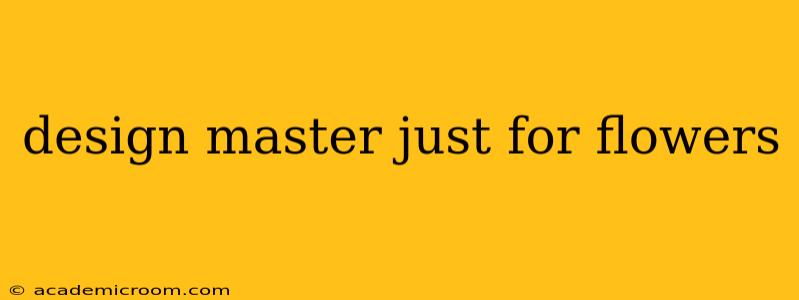Are you passionate about flowers and eager to elevate your floral design skills to a professional level? This masterclass delves into the art and science of floral arranging, equipping you with the techniques and knowledge to create stunning and unforgettable designs. Whether you're a hobbyist looking to refine your skills or an aspiring florist aiming to launch a successful business, this comprehensive guide will be your invaluable resource.
What Makes a Great Floral Design?
Before diving into specific techniques, let's establish the foundational principles of exceptional floral design. A truly masterful arrangement isn't just about pretty flowers; it's about achieving a harmonious balance of elements, creating a visual narrative, and evoking emotion. This involves understanding:
- Color Theory: Mastering color palettes is crucial. Learn about analogous, complementary, and triadic color schemes and how they impact the mood and overall impression of your arrangement. Experiment with both vibrant and muted tones to achieve diverse effects.
- Form and Line: The shape and structure of your design are equally vital. Consider the height, width, and depth of your arrangement and how different flower types contribute to the overall form. Learn techniques to create focal points, leading lines, and visual interest.
- Texture and Scale: Incorporating a variety of textures, from delicate petals to rugged foliage, adds depth and complexity. Understanding scale – the relative size of elements within the arrangement – is crucial for achieving visual harmony.
- Balance and Proportion: Achieving balance is key to a successful arrangement. Explore symmetrical and asymmetrical balance techniques and how to utilize various elements to create visual equilibrium.
What are the different types of floral arrangements?
This is a frequently asked question, and the answer is surprisingly diverse! Floral arrangements aren't simply "bouquets." They encompass a vast spectrum of styles, each with its own unique characteristics and design principles. Some popular types include:
- Bouquets: The classic, handheld arrangement, ranging from simple posies to elaborate cascading designs. Understanding the different bouquet styles (e.g., round, crescent, cascade) is essential.
- Centerpieces: Designed for table settings, centerpieces can be low and sprawling or tall and dramatic, adapting to the event's style and ambiance.
- Wreaths and Garlands: These circular and linear designs are perfect for decorative accents, adding elegance to doorways, walls, or event spaces.
- Floral Crowns and Headpieces: These intricate arrangements showcase the artistry of floral design in a wearable format.
- Corsages and Boutonnieres: Small, elegant arrangements worn as accessories, often used for formal events.
What are the best flowers for beginners?
Choosing the right flowers is paramount, particularly for beginners. Certain blooms are more forgiving and easier to work with, allowing you to focus on fundamental techniques without frustration. Some excellent options include:
- Roses: Their classic beauty and durability make them a great starting point.
- Sunflowers: Their bold size and vibrant color add immediate impact.
- Chrysanthemums: These readily available flowers offer a wide range of colors and forms.
- Hydrangeas: Their large, showy blooms are striking and relatively easy to arrange.
- Carnations: Their long stems and diverse colors are ideal for beginners.
What tools and materials do I need for floral arranging?
Investing in the right tools is key to creating professional-quality floral arrangements. Essential items include:
- Floral Shears or Snips: Sharp, clean cuts are crucial for flower longevity.
- Floral Tape: Secures stems and helps create a cohesive look.
- Floral Foam: Provides support and hydration for the flowers.
- Floral Wire: Useful for creating unique structures and supporting delicate blooms.
- Vases and Containers: Select containers that complement your design style and flower choices.
How long do cut flowers last?
Flower longevity depends on several factors, including the type of flower, the freshness of the blooms, and proper care. However, with the right techniques, you can significantly extend their lifespan. This involves:
- Proper Hydration: Cut stems under water to minimize air bubble entry.
- Removing Lower Leaves: Leaves submerged in water promote bacterial growth.
- Using Flower Food: Nourishes flowers and extends their life.
- Storing in a Cool Place: Avoid direct sunlight and heat.
This masterclass serves as a starting point for your journey into floral design. Practice, experimentation, and a keen eye for detail are vital ingredients to mastering this captivating art form. Embrace your creativity, and let your floral designs tell your unique story.
